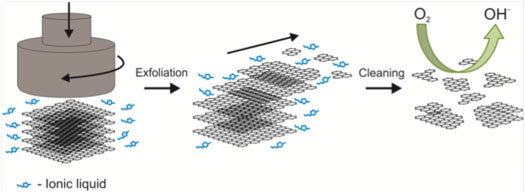| Posted: Nov 13, 2014 |
Tuning the catalytic activity of graphene nanosheets for oxygen reduction reaction via size and thickness reduction
|
|
(Nanowerk News) The Ulster lab of Professor Pagona Papakonstantinou has shown that small size pure graphene nanosheets may work as an effective catalyst for breaking oxygen molecules – a reaction, which is of importance in the operation of fuel cells and air batteries, both of which have the potential to power electronic devices, vehicles, aircrafts and equipment. They discovered that ultrathin and small size graphene sheets possess an unusually high number of edges and a high conductivity, which help to drive the cracking of oxygen more efficiently compared to thicker and larger flakes.
|
|
The research is the subject of a new paper in the American Chemical Society journal ACS Applied Materials and Interfaces ("Tuning the Catalytic Activity of Graphene Nanosheets for Oxygen Reduction Reaction via Size and Thickness Reduction").
|
 |
|
Both Edges and thickness are important, explains Pagona Papakonstantinou, who led the study at University of Ulster. Apparently the edges are the sites where oxygen attaches and breaks more easily compared to the central material. Another important factor that contributes to the catalyst’s activity is its ultralow thickness. The conductivity of ultrathin nanosheets is larger than that of the thicker ones. Therefore to design superior catalysts, one should maximize the proportion of edges by reducing the size and maximize conductivity by reducing the thickness.
|
|
The Ulster scientists developed a synthesis strategy that imparts a high degree of edges and exfoliation without comprising the purity of the material. They produced nanosized graphene by grinding graphite with a small amount of ionic liquid. The grinding process breaks graphite to very small fragments, whereas the ionic liquid acts a lubricant that exfoliates the small graphite fragments to thinner ones. Then they cleaned the ionic liquid and used their knowledge to separate graphene to various sizes and thicknesses using the centrifugation technique.
|
|
This approach opens horizons to controllably prepare nanosized graphene and other 2-dimensional materials with superior properties for applications in catalytic reactions driven by electricity or sunlight.
|
|
This research was a collaborative effort between the University of Ulster, Peking University (lead by Prof Meixian Li), Nanjing University (lead by Prof Peng Wang) and Southeast University (lead by Litao Sun).
|
|
The research was supported by a Leverhulme Trust/Royal Academy of Engineering Senior Research Fellowship ( to P. Papakonstantinou); a Ph.D. Studentship to J.Benson from the Department of Education in Northern Ireland; a visiting Senior Research Fellowship to M. Li by the University of Ulster; The Chinese Thousand-Talents plan program and the Jiangsu Shuangchuang program (Q. Xu and P. Wang).
|

